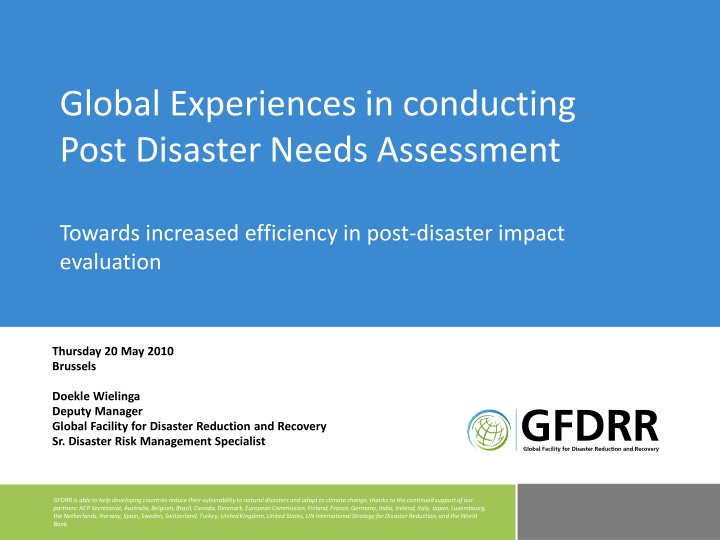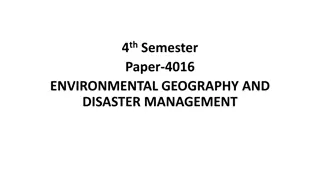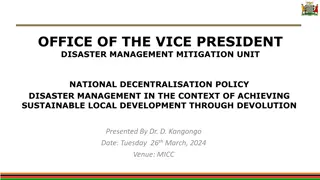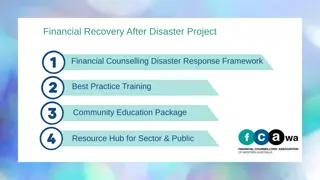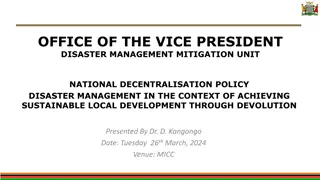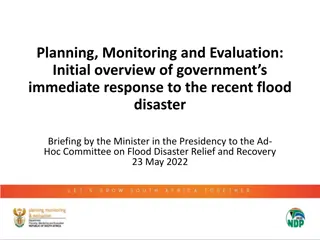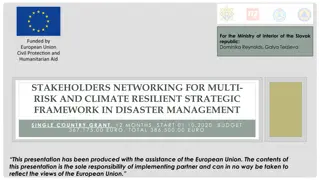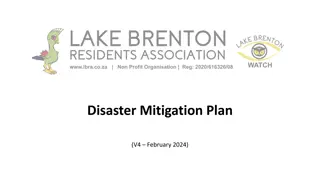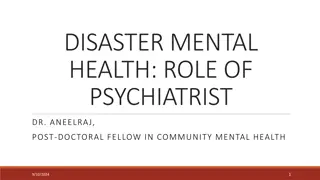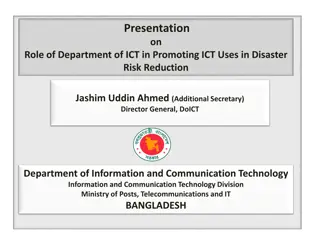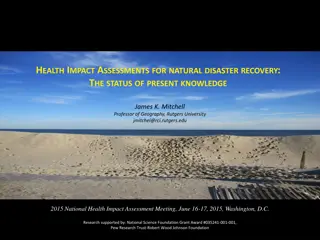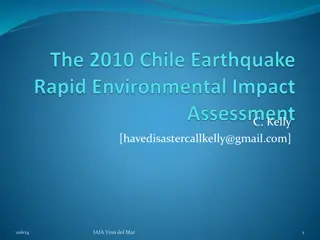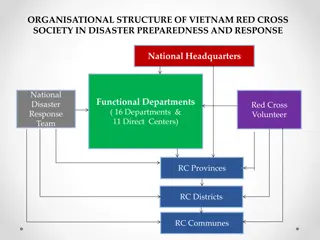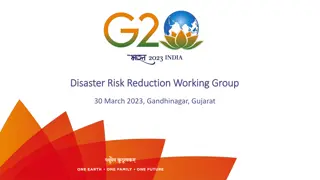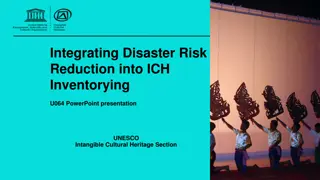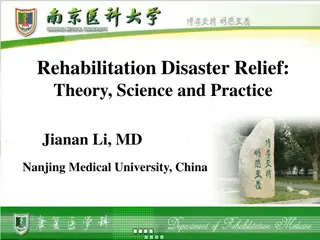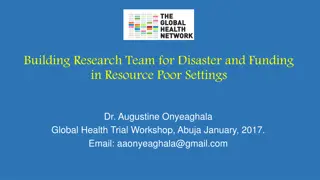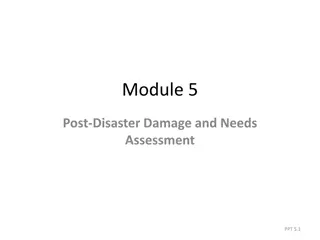Global Experiences in Post-Disaster Needs Assessment for Enhanced Impact Evaluation
Conducting post-disaster needs assessment is crucial for efficient post-disaster impact evaluation. GFDRR, with support from various partners, aids developing countries in reducing vulnerability to natural disasters and adapting to climate change. The initiative is a global response to increasing disaster risks, making disaster risk management integral to long-term development agendas of disaster-prone economies. Established in 2006, GFDRR facilitates knowledge exchange, implementation of the Hyogo Framework of Action, and global coordination in disaster risk reduction.
Download Presentation

Please find below an Image/Link to download the presentation.
The content on the website is provided AS IS for your information and personal use only. It may not be sold, licensed, or shared on other websites without obtaining consent from the author.If you encounter any issues during the download, it is possible that the publisher has removed the file from their server.
You are allowed to download the files provided on this website for personal or commercial use, subject to the condition that they are used lawfully. All files are the property of their respective owners.
The content on the website is provided AS IS for your information and personal use only. It may not be sold, licensed, or shared on other websites without obtaining consent from the author.
E N D
Presentation Transcript
Global Experiences in conducting Post Disaster Needs Assessment Towards increased efficiency in post-disaster impact evaluation Thursday 20 May 2010 Brussels Doekle Wielinga Deputy Manager Global Facility for Disaster Reduction and Recovery Sr. Disaster Risk Management Specialist GFDRR is able to help developing countries reduce their vulnerability to natural disasters and adapt to climate change, thanks to the continued support of our partners: ACP Secretariat, Australia, Belgium, Brazil, Canada, Denmark, European Commission, Finland, France, Germany, India, Ireland, Italy, Japan, Luxembourg, the Netherlands, Norway, Spain, Sweden, Switzerland, Turkey, United Kingdom, United States, UN International Strategy for Disaster Reduction, and the World Bank.
Global Distribution of Multiple Hazards Mortality Risk GFDRR is the collective commitment of the Governments, UN and the WB to make disaster (risk) management integral to the longer term development agenda of the disaster-prone economies. Source: UN Global Assessment Report on Disaster Risk Reduction 2009 GFDRR is able to help developing countries reduce their vulnerability to natural disasters and adapt to climate change, thanks to the continued support of our partners: ACP Secretariat, Australia, Belgium, Brazil, Canada, Denmark, European Commission, Finland, France, Germany, India, Ireland, Italy, Japan, Luxembourg, the Netherlands, Norway, Spain, Sweden, Switzerland, Turkey, United Kingdom, United States, UN International Strategy for Disaster Reduction, and the World Bank.
GFDRR is the global response to this global challenge of increasing disaster risks to development Established in 2006 in the wake of increased global awareness and political commitment after the Indian Ocean tsunami [2005] Assist developing countries to implement Hyogo Framework of Action (HFA) adopted by 168 nations in Kobe, Japan [2005] Facilitate global sharing and exchange of knowledge and experiences in all aspects of disaster risk management Leveraging World Bank s analytical and advisory services, and reconstruction and development financing for mainstreaming disaster prevention Model Partnership to ensure global coordination in managing and reducing risks of disasters among the key stakeholders(developing countries, emerging economies, donors, UN, Red Cross/Crescent, WB and others) GFDRR is able to help developing countries reduce their vulnerability to natural disasters and adapt to climate change, thanks to the continued support of our partners: ACP Secretariat, Australia, Belgium, Brazil, Canada, Denmark, European Commission, Finland, France, Germany, India, Ireland, Italy, Japan, Luxembourg, the Netherlands, Norway, Spain, Sweden, Switzerland, Turkey, United Kingdom, United States, UN International Strategy for Disaster Reduction, and the World Bank.
GFDRR Consultative Group fosters North-South and South-South Cooperation in disaster prevention and preparedness GFDRR is able to help developing countries reduce their vulnerability to natural disasters and adapt to climate change, thanks to the continued support of our partners: ACP Secretariat, Australia, Belgium, Brazil, Canada, Denmark, European Commission, Finland, France, Germany, India, Ireland, Italy, Japan, Luxembourg, the Netherlands, Norway, Spain, Sweden, Switzerland, Turkey, United Kingdom, United States, UN International Strategy for Disaster Reduction, and the World Bank.
The GFDRR Business Model Global and regional partnerships ( Track I ) Building Stronger and inclusive Partnerships, Broadening GFDDR Governance, expanding (sub) regional cooperation, harnessing the Private sector Tools and Methodologies Mainstreaming disaster risk reduction and Climate Change Adaptation ( Track II ) Mainstreaming at policy level and within sector development, institutional strengthening, DRR focus on urbanization and adaptation to climate change Special Initiatives: The Economics of Disaster Risk Reduction Generate evidence for disaster risk reduction South-South Cooperation Enhancing collaboration among Southern Governments, institutions, networks, and communities Ex Ante Knowledge Sharing Capacity Building Disaster Risk Reduction is Integral Part of Sustainable Development Partnership for Sustainable Recovery ( Track III ) Resilient recovery: institutional strengthening, improving coordination in recovery assistance, accelerate recovery financing that invests in disaster risk reduction Ex Post
Track III: Sustainable Post-Disaster Recovery GFDRR established in 2007 the Standby Recovery Financing Facility (SRFF) - to bridge the gap between humanitarian assistance in the wake of a disaster and longer term recovery. GFDRR Track III encompasses two financing windows : TA Fund, to support ex-ante and ex-post technical assistance Post Disaster Needs Assessments (PDNAs) jointly with EC and UN, planning, and capacity building. Callable Fund, to provide speedy access to financial resources for disaster recovery.
Why is Recovery important Links the humanitarian phase to the long-term reconstruction phase It is a window of opportunity to bring attention to the importance of DRR especially in LICs (limited fiscal space/no incentive to invest in disaster prevention) and integrate risk reduction both at policy and sector level It links with ex ante disaster prevention and climate change adaptation to reduce long-term vulnerability Provides an opportunity to promote Build Better : new constructions should meet modern standards, not just be better than the destroyed (safe schools and hospitals)
Elements of a Recovery Planning Process 2/24/2025 8
Joint EC-WB-UN in-country PDNAs since 2007 Completed: Bangladesh (2008) Bolivia (2008) Madagascar (2008) Myanmar (2008) Haiti (2008) Yemen (2008) Namibia (2009) Planned: Chili (2010) Funding for Post Disaster Recovery Activities (list some countries) Central African Republic (2009) Samoa (2009) The Philippines (2009) Indonesia (2009) Lao PDR (2009) Cambodia (2009) Burkina Faso (2009) Senegal (2009) El Salvador (2009)
Post Disaster Needs Assessment - PDNA - = Evaluation of impact and needs for recovery and reconstruction Government-led, supported by the international community Platform for technical and financial coordination in recovery and reconstruction planning and implementation An evaluation that integrates risk reduction in sector approaches as well at strategy level Essential building block of sustainable recovery and reconstruction GFDRR s role as facilitator of the PDNA 1. 2. 3. 4. 5. 6.
1. Objectives of a PDNA: 1. Quantitative estimation of the value of destruction or damage to assets and of changes or losses in economic flows due to the disaster 2. To identify the possible impact of the disaster on the overall performance of the economy of the affected country or area, and also on individual persons or on households 3. To estimate financial, technical and human needs to implement the agreed upon programs of recovery, reconstruction and risk management 4. To identify the capacity of the State to undertake on its own all recovery, reconstruction, and disaster risk management programs and activities 5. To ascertain whether international assistance is needed its scope and timeframe 6. To identify specific public sector actions at the State or lower levels to be undertaken in the short, medium and long term to ensure recovery and reconstruction
2. Government Ownership: Governments increasingly customize the Post Disaster Needs Assessment to their specific needs. .. Haiti, Philippines, Indonesia Tendency towards a more pro-active ownership of the PDNA process, compare to a more passive approach previously .. Namibia, Burkina Faso, Indonesia, Haiti Regional organizations can play an important role . ASEAN in Myanmar and ECOWAS for West Africa Partnership approach requires new communication practices from affected Governments with the international community .Joint instead of individual
3. Coordination & Partnership: Increasing interest of global, regional organizations, bilateral donors and neighboring countries to participate ... Myanmar, Indonesia, Samoa ... Haiti the entire international community was united, including EC and EU members states PDNA becomes a platform to further coordinate recovery and reconstruction and leads to new partnerships Haiti Reconstruction Fund Tri-partite Joint Declaration EC, WB, UN ... MoU ASEAN, WB, UNISDR Random Hackers of Kindness, JRC, UNOSAT Need to streamline the mobilization of experts, protocols of cooperation and methodology to address human needs ... Rosters of national, regional and global experts . ... Standard operating procedures from alert to lessons learned ... PDNA Handbook
4. Disaster Risk Reduction: Disaster risk reduction is integrated into sector analysis to make the needs assessment disaster proof Madagascar, Namibia, Senegal, Yemen A section dedicated to disaster risk management to address the policy, strategy and institutional issues all assessments; Bangladesh, Yemen, El Salvador, Haiti Disasters: Shift from response to preparedness and development
5. Sustainable Recovery & Reconstruction: Needs are assessed as part of an overarching strategy that addresses the immediate, medium-term and long term recovery and reconstruction needs Funds are leveraged based upon the PDNA results Bangladesh US$ 109 Million, incl. US$ 2.3 Million form GFDRR Central African Republic US$ 5.4 Million, Samoa US$ 40 Million Haiti US$ 9.9 Billion . The recovery process is monitored to provide guidance to decision makers Social Impact Monitoring in Myanmar The post-disaster situation provides the opportunity to establish or strengthen a long term partnership in risk reduction flood management in Yemen flood protection for Metro Manila risk reduction becomes mayor theme of El Salvador s 5 year development plan
6. Role of GFDRR as facilitator of the PDNA -1-: From 2008 onwards GFDRR, through its Standby Recovery Financing Facility (SRFF) has financially and technically supported 19 Post Disaster Needs Assessment - 18 PDNA, 1 PCNA- The average contribution to a PDNA has been US$ 240,000, though small scale disaster require US$ 100,000 while catastrophic disasters (Myanmar, Haiti Earthquake) require US$ 500,000 and above Technical expertise is provided at coordination level and sector level, utilizing a WB internal roster; the Quick Reaction Team, and an ever increasing external roster; the Global Expert Team Coordination with the EC started in 2006 , facilitated by DG Relex/Crisis Unit
6. Role of GFDRR as facilitator of the PDNA - 2 -: The SRFF is increasingly becoming the global coordination hub for financing PDNA and mobilize the required expertise and knowledge through innovative mechanisms administrating funds for partners roster of experts Quick Reaction Team and Global Expert Team hosting EU member state and emerging economy experts ... guidance and best practice notes EC is one of the most important GFDRR partners that facilitates PDNA financing
Thank You!
